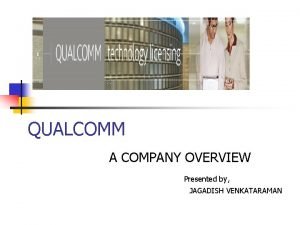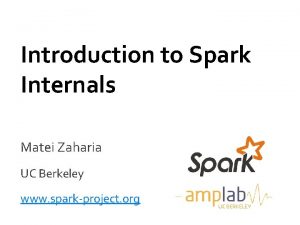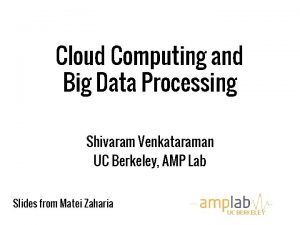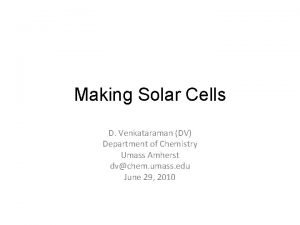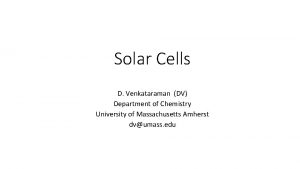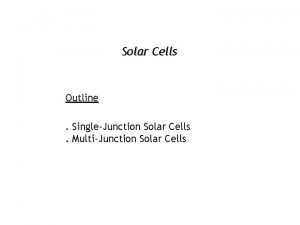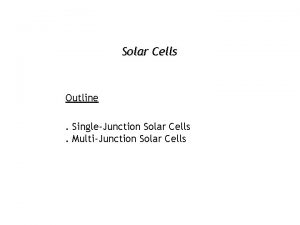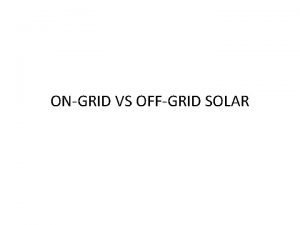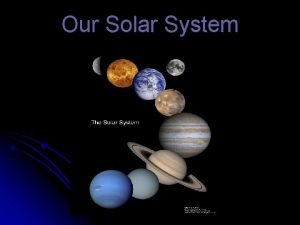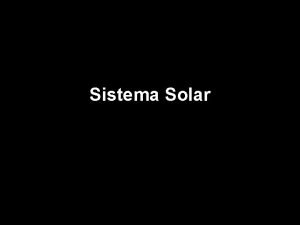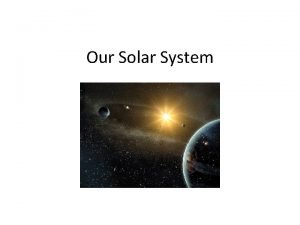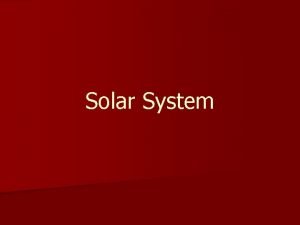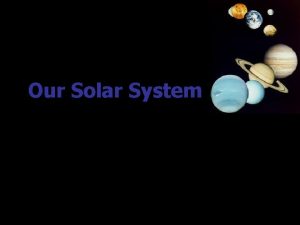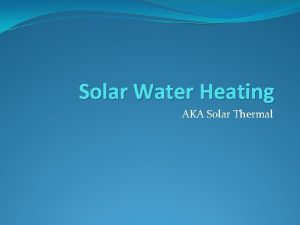Making Solar Cells Prof D Venkataraman DV Department

















- Slides: 17

Making Solar Cells Prof. D. Venkataraman (DV) Department of Chemistry UMass Amherst dv@chem. umass. edu http: //thedvgroup. com UMass Amherst

Why Care about Photovoltaic Cells? 2

US needs ~98 Quads of Energy 68% Waste 3

Units of Energy 1 Quad = 1015 BTU (Quadrillion British Thermal Units) = 8, 007, 000 Gallons of gasoline = 1018 joules Power = Energy transfer rate 1 Watt = 1 joule of energy transferred in 1 sec 1 k. W h = 3. 6 x 106 joules (3. 6 megajoules) US Energy Need/Person/Year= ~1012 Joules = Energy from 1 nuclear bomb 4

US needs ~98 Quads of Energy 68% Waste 5

Why Care about Photovoltaic Cells? US Cell Phone Need = 327 MW Fukushima Reactor = 460 MW World Need = 5. 6 GW World Economic Forum 6

~106 J/day/m 2 7

Solar Cells Target = 1020 Joules/y Ø Ø ~10% of US area = 1020 J/y ü Energy Magnitude Renewable Source of Energy Cost = ~$0. 25/k. W h ü Economic Viability No CO 2 emissions during energy ü Environmental Impact conversion ü Equity Production of Si: Si. O 2 + C Si + CO 2 1 ton of Si = 1. 6 tons of CO 2 “Photovoltaic energy production will benefit global society by creating jobs, distributing energy supplies, and preventing pollution that results in health, and environmental degradation. ” In Photovoltaics — a path to sustainable futures, Futures, 2002, 7, 663 -674 8

“I’d put my money on the sun and solar energy. What a source of power! I hope we don’t have to wait until oil and coal run out before we tackle that. ” Thomas Edison In 1931 to Henry Ford and Harvey Firestone From Current Thinking by Heather Rogers in New York Times, June 3, 2007 9

Photovoltaic Cells Exciton Active Layer Efficiency of Photovoltaic Cells Depend on v. Absorption in the Solar Spectrum v. Charge Separation v. Charge Mobility v. Charge Collection 10

Single Junction Photovoltaic Cells Source: NREL Active Layers: Ø Crystalline Silicon Ø Amorphous Silicon Inorganic Ø Gallium Arsenide Ø Copper-Indium-Gallium-Selenide (CIGS) Hybrid Ø Titanium dioxide/dyes Ø Carbon Nanotubes, Carbon-based Polymers Organic PVs & Molecules 11

Solar Cells ü ü ü ü Energy Magnitude Economic Viability Environmental Impact Equity 12

Organic Solar Cells ü ü Making active layers materials is not energy intensive Carbon-based active layers are inexpensive Carbon-based active layers are light Flexible solar cells 13

14

15

Exciton Diffusion Distances in OPV and Si Cells Si or III-V Cells Exciton diffusion distance >100 nm Excitons loosely bound Organic/Hybrid/Dyesensitized 10 nm Exciton diffusion distance <10 nm Excitons tightly bound (Frenkel Excitons) Low dielectric constant Gregg, B. A. , Excitonic solar cells. Journal of Physical Chemistry B 2003, 107 (20), 4688 -4698. 16

17
 Shobha venkataraman
Shobha venkataraman Jagadish venkataraman
Jagadish venkataraman Balaji mooc
Balaji mooc Spark internals
Spark internals Shivaram venkataraman
Shivaram venkataraman Archana venkataraman
Archana venkataraman Submentovertical projection
Submentovertical projection Tubular secretion
Tubular secretion Thyroid gland
Thyroid gland Somatic vs gamete
Somatic vs gamete Why dna is more stable than rna?
Why dna is more stable than rna? Red blood cells and white blood cells difference
Red blood cells and white blood cells difference Ghonarea
Ghonarea Plant and animal cell venn diagram
Plant and animal cell venn diagram Prokaryotic cells vs eukaryotic cells venn diagram
Prokaryotic cells vs eukaryotic cells venn diagram Organelle trail
Organelle trail Masses of cells form and steal nutrients from healthy cells
Masses of cells form and steal nutrients from healthy cells Label
Label

